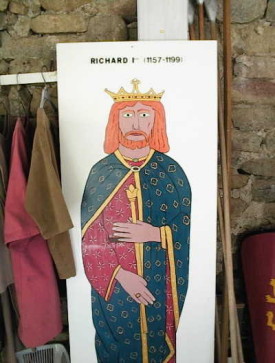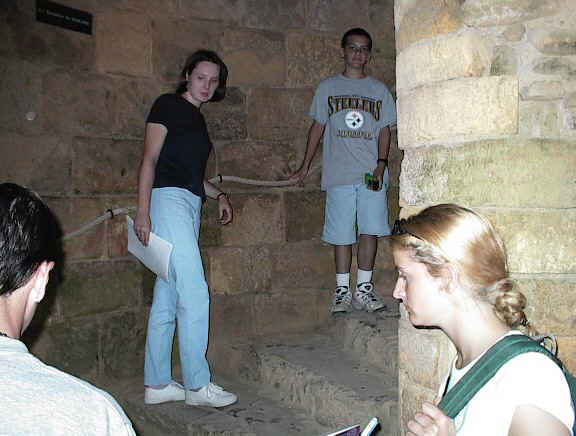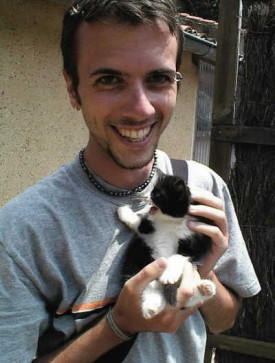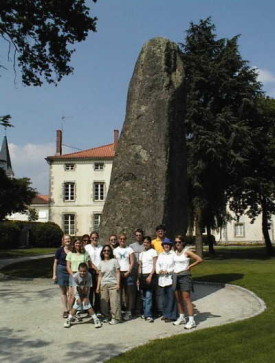
West Virginia University in Vendée, France

Lions, and tigers, and bears, oh my!!!
June 15, 1999
I've long held the theory that The Wizard of Oz is the single most quoted work of literatue in the United States. It is thus with great pleasure that I summarize today's WVU-V in these terms. The Lion, as you will see, is that of Richard the Lion-Hearted, the Tiger is the nickname of Georges Clemenceau, and the Bear is the creature that so often threatened primitive man in pre-historic Europe.
Much of our regular class session yesterday was spent exploring the contributions of Georges Clemenceau to the life of modern France. He played a major role in the late 1800's in steering this country toward away from monarchy and empire toward its current form of republican government. He also played a critical role in squashing the anti-semitic nationalists who unjustly condemned Alfred Dreyfus to Devil's Island. Clemenceau was the only newspaper editor who had the audacity to publish Emile Zola's crucially important letter, now known as "J'accuse", a title suggested by Clemenceau himself. Finally, Clemenceau is just as well known in France as the "Father of Victory" in World War I.
Below, Albert, our guide to Clemenceau's Vendée home opens up to us a world of passion for justice that earned this great leader the nickname of "Le Tigre" or "The Tiger."
One of Clemeceau's best life-long friends was the artist Claude Monet. Below, the chief gardner at Clemenceau's house explains how Monet and Clemenceau created a space here on the coast of Vendée after the model of Monet's own Giverny in Normandy.
Recreating a Normandy-style garden in the sands on these coasts was nothing less than a miracle of will -- just up Clemenceau's alley. This year marks the 70th anniversary of the Tiger's death and his plants, some planted by his own hand, still thrive.
It was after his retirement from political life that Clemenceau killed the tiger below, but it is emblematic of his spirit of steadfast principle. A bit ironically, the animal was hunted down in the jungles of a country far from Clemenceau's native France. A great travellor and adventurer, one of Clemenceau's cherished humanitarian causes was his fight against French (and every other nation's) colonialism in lesser developed parts of the world.
After the visit to Clemenceau's home, we return a few kilometers inland to the town of Talmont-Saint-Hilaire. On the horizon below we see the ruins of the castle of Talmont, which was reduced to its current state by Richelieu in the 1700's. This region and especially the nearby La Rochelle had become a stronghold for Protestantism, which the grand Cardinal considered a threat to his ambitions of unifying all of France under the absolute authority of the Crown and of the Church.
This castle was first built by the counts of Talmont early in the 11th century, and it was by rights within the domain of the Dukes of Aquitaine. When the Duchess Eleanor of Aquitaine married the king of France, this region appeared destined to be a part of France, a kingdom that at that time was limited to the areas immediately surrounding the city of Paris. Eleanor even accompanied her husband Louis VII on the Second Crusade, but their marriage was doomed in part by the Duchess's strong will and spirit of independence. A divorce was the result, and almost immediately Eleanor married Henry Plantagenêt, of the family of William the Conqueror. Two years later, in 1154, Henry Plantagenêt would be crowned Henry II, king of England. The greatest count of Talmont was soon to be born of this marriage. The title Count of Talmont is little known to many of us who know him better as Richard the Lion-Hearted, king of England, Duke of Normandy and Aquitaine.

Richard died in 1199, that is 800 years ago. We had already seen expositions marking this centennial in Paris, so it is little surprise to see others here in old Aquitaine.
Our group today was a bit surprised to see the our visit to the
castle of Talmont had been prepared in English. Upon reflection, this was perfectly
logical since many English speakers will follow the paths of king Richard this year.
The linguistic part of our program seemed for a moment compromised, but in the land
of Richard no mission is impossible. Our gracious guide to Talmont today, center
below, is Elizabeth McCrindle, a native herself of the jolly isle across the Channel.
She kindly accepts to lead us through the castle in Richard's own
native tongue (that is French!), and we are charmed by the vibrance and clarity of her
explanations. Her commentaries in the end are one more great inspiration to
those of us who would speak the languages of two great kingdoms --
England and France!

Below we see original walls from the 11th century.
Until recently the sea washed against the walls of this castle, but now the Atlantic is barely visible over Brad Gunnell's shoulder.
The castle was originally built around an early Romanesque church, whose frontal arches are now perfectly well conserved within the fortifications.
Freddy Perkins is sure that this kitten is descended from the more ferocious felines emblematic of the Lion-Heart.

After Talmont, we travel a few kilometers down the road to the CAIRN. "Cairn" is a Celtic word designating a stone structure surrounding a primitive burial place. Here it also means "Centre Archéologique d'Initiation à la Recherche sur le Néolithique." Our guide here, Johnny Ferré, shows us how to make a variety of tools from flint. No wild bears would dare disturb humans so well defended!
Today, the CAIRN is visited by a journalist from Ouest France, Gérard Cortez. Once more, WVU-V finds itself in the eyes of the press! We may be a part of this report on the oldest stones in Europe. Watch your news stands.
The WVU-Vendéens gather before a reconstruction of a pre-historic great-house.
Below is our now traditional photo inside a cairn in the heart of Vendée.
Also traditional is Johnny's demonstration on how primitive Europeans made fire. Click on the image for the results of Johnn's efforts.
No visit would be complete without a pose before the great stones "in the field." Here we pose before the tallest "menhir" of the region, known as the "king" of the tall stones.

The function of the single tall stones is still not clear, but the "dolmens," great rocks forming a table and originally completely enclosed by earth or smaller stones, were actually burial places for primitive man. The "Dolmen de la Frébouchère" below is one of the oldest monuments known to man and among the 10 largest in all of Europe.
High ceilings 6,000 years before Christ were not yet a serious aim of architecture, but it is still possble to walk around in this ancient tomb, as Kelly, Alexander, and Nicole demonstrate below.
Stay tuned to WVU-V!
Go on to June 16, 1999
Return to the 1999 Calendar
Comments to mlasting@wvu.edu